Opening a preschool is a beautiful and inspiring journey, and this article serves as the ultimate guide to starting a preschool.
However, before you welcome your first child, you’ll need to navigate two crucial pillars: licensing and compliance, and facility planning. Together, these decisions shape everything that follows: your financial model, staffing plan, and the character of your school community.
In this guide, we will walk through how to open a preschool in ways that are both sustainable and true to your educational vision. Whether you are planning a Montessori program or another approach to early learning, the same principles apply: clarity of purpose, thoughtful preparation, and a deep respect for the children and families you will serve.
Setting the Foundation
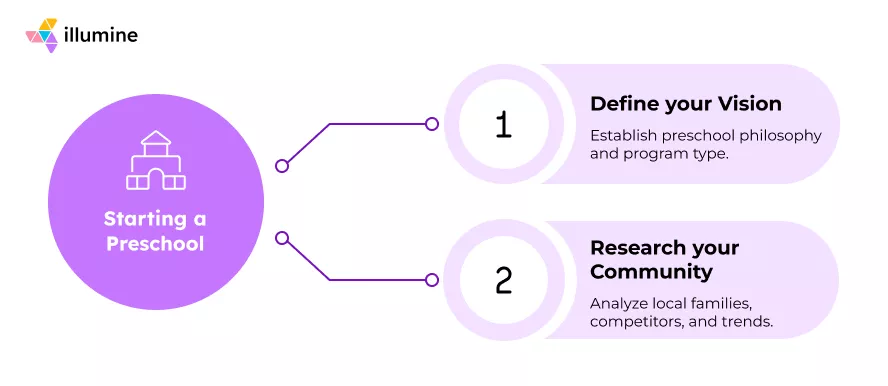
Before the first toy is unpacked or the first classroom designed, your preschool begins as an idea; a vision of what you hope to offer children and families. Careful planning at this stage is essential for a successful preschool launch.
This section will help you define that vision and understand the landscape in which your school will take shape.
Step 1: Define Your Preschool Vision and Program Type
Every great school begins with clarity.
Ask yourself: What kind of program am I creating?
Different states regulate early childhood programs under various categories, and the distinctions matter.
Here are the most common types:
- Child-Care Center or Nursery School: Typically licensed under child-care licensing laws.
- Private or Nonpublic Preschool: Often overseen by the US Department of Education, especially for programs serving children over age five.
- Faith-Based or Exempt Programs: Sometimes eligible for partial exemptions but still expected to meet basic health and safety standards.
- Montessori or Hybrid Programs: These may fall under one or more of the above depending on age range and operating hours. A Montessori preschool, for instance, might serve toddlers under child-care regulations while its older classrooms fall under private-school guidelines.
Step 2: Research the Market and Your Community
Once your vision is clear, study your surroundings carefully. A successful preschool meets real needs within its community.
- Identify Local Competitors: Visit other preschools and childcare centers nearby. Study their pricing, hours, enrollment models, and teaching philosophies. Look at parent reviews and community feedback to understand what families appreciate, and what they feel is missing.
- Survey Parents: Ask parents what they value most in early education. Do they prioritize safety, small group sizes, a Montessori environment, or flexible hours? Simple surveys or conversations at community events can provide valuable insights. Additionally, connecting with local parent groups can help you gather broader perspectives on community needs.
- Analyze Demographics: Choose a location where young families are growing in number. Look at nearby housing developments, schools, and commuting patterns.
- Track Early Education Trends: STEM (Science, Technology, Engineering, Mathematics) integration, bilingual programs, and nature-based learning are increasingly in demand. Knowing where the interest lies helps you position your preschool effectively.
Business Plan and Strategy
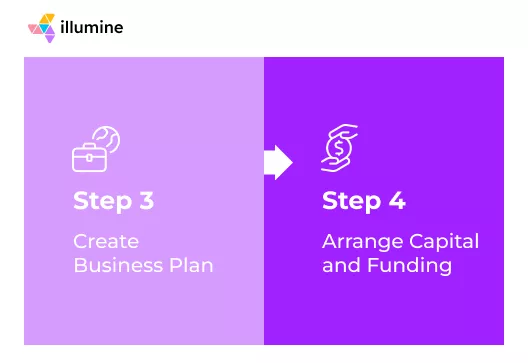
Once you have defined your vision and understood your community, it is time to translate your ideas into a clear plan.
A strong preschool business plan gives your school direction and structure. It also becomes the document you will share with partners, investors, and licensing officials. Many factors, such as location, facility type, and curriculum, will shape your business plan and strategy.
Step 3: Create a Comprehensive Preschool Business Plan
Think of your business plan as a roadmap. It does not have to be complicated, but it must be thoughtful and complete.
Key elements to include:
- Executive Summary: A short statement of your school’s purpose and what makes it special.
- Market Analysis: Summarize what you learned from your competitor and parent research.
- Operational Plan: Outline the day-to-day operations of your preschool, including hours of operation, staff roles, and curriculum structure.
- Financial Plan: Include start-up costs, tuition projections, and a break-even analysis.
- Marketing Plan: Describe how you will reach families and build trust in your community.
Step 4: Arrange Capital and Funding
Starting a preschool requires a significant investment. Plan for facility costs, licensing fees, insurance, and classroom materials.
Possible funding sources include:
- Personal Savings and Loans: Many founders combine personal resources with small-business or SBA (Small Business Administration) loans. You may also consider applying for a small business loan as a financing option.
- Grants and Community Programs: Some states and educational organizations offer grants for early childhood centers.
- Investors or Partners: Families, local philanthropists, or mission-aligned investors can help bring your school to life.
- Crowdfunding: Platforms like GoFundMe or Kickstarter can be effective if you have a strong story and community support.
To set expectations, here are some realistic cost ranges:
Even a modest leased facility for 60–80 children can require $250,000–$400,000 to launch.
A larger owned space for 100–120 students may reach $600,000–$900,000 or more.
Legal and Licensing Essentials
Licensing is often seen as paperwork, but it is really about safety, transparency, and trust.
Understanding your state’s requirements from the beginning prevents costly surprises later.
Be sure to research and comply with preschool licensing requirements specific to your state to ensure you meet all necessary regulations for operating a licensed preschool.
Step 5: Learn the Licensing Rules That Apply to You
Each state or region regulates early childhood programs differently. Licensing will determine staff ratios, inspections, safety standards, and teacher qualifications.
When considering staff-to-child ratios, keep in mind that licensing rules also determine how many children you can enroll based on your facility size and staffing levels.
For example, here are two states with different requirements:
Florida (Child Care Facility Standards):
Maryland (COMAR 13A.16.08.03):
Montessori classrooms often operate a little differently. In an authentic environment, children work independently and rely on the prepared classroom rather than constant adult direction.
Typical Montessori ratios are:
- Toddler Community (18 months – 3 years): 1 adult to 5 – 8 children.
- Primary (3 – 6 years): 1 adult to 12 – 15 children, sometimes higher when led by an experienced certified guide.
Assistants may support the lead teacher but are not always counted once the class is established.
Always confirm your ratios comply with your state’s legal minimums, even when Montessori practice allows more flexibility.
Step 6: Secure the Necessary Permits and Policies
Before your school can open, you’ll need to secure the required licenses and approvals.
The most important is the childcare license, which confirms that your program meets basic standards for health, safety, and education. In California, for example, the Department of Social Services issues this license after inspecting the facility.
You will also need:
- Zoning Approval: Verify that your property can legally operate as a preschool.
- Health and Safety Inspections: Fire, sanitation, and building inspections ensure a safe environment.
- Food Handling Permit: Required if meals or snacks are prepared on site.
- Documentation and Insurance: Prepare written policies for admissions, health, discipline, and emergencies. Maintain liability, property, and workers’ compensation insurance.
Good documentation protects everyone. It gives families confidence and helps your staff act quickly when challenges arise.
Facility Planning and Setup
A well-designed preschool facility is essential for supporting children's learning and development. The building you choose will shape your daily rhythm and your financial stability. A well-planned facility supports both your educational vision and the comfort of the families you serve.
Step 7: Choose the Right Location
Location is one of the biggest decisions you will make. It affects everything from enrollment to your school’s sense of community.
When evaluating sites, look for:
- Demographics: Areas with growing numbers of young families are ideal.
- Accessibility: Ensure the site is easy to reach by car and public transport, with safe parking or drop-off zones.
- Safety: Choose quiet, low-crime neighborhoods away from busy roads. Make sure the property can be fenced and secured.
- Zoning: Confirm that your location is approved for educational use before signing any lease or contract.
Lease, Purchase, or Build?
Each option has advantages:
Before finalizing any property, walk through it with your local licensing and fire officials. Their early feedback will help prevent expensive changes later.
Step 8: Plan Facility Size, Layout, and Growth
Most states require a minimum of 35 square feet of indoor space per child and about 75 square feet of outdoor space. Once you add storage, bathrooms, and offices, plan for roughly 60–75 square feet per child overall.
Step 9: Prepare and Equip the Facility
Once the walls are up, the details bring your school to life.
- Classrooms: Choose child-sized furniture, open shelving, and defined spaces for reading, play, and rest.
- Outdoor Areas: Provide age-appropriate play equipment and shaded rest zones. The National Association for the Education of Young Children (NAEYC) recommends at least one hour of outdoor play daily.
- Cleanliness and Hygiene: Create a cleaning schedule, install accessible sinks, and maintain good ventilation.
- Accessibility: Design spaces that are inclusive of all children and meet ADA standards.
Building a Strong Team and Safe Environment
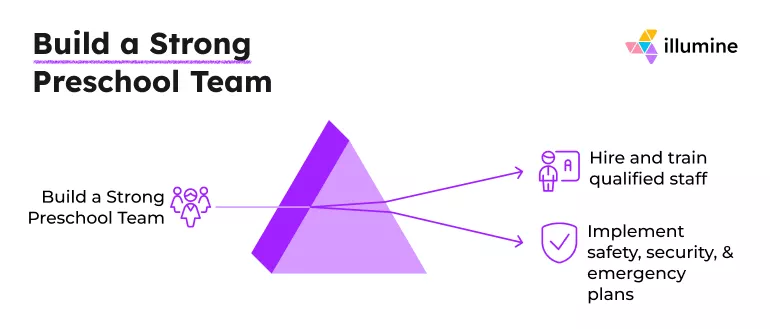
A school is only as strong as its people. The teachers and caregivers you hire will shape the atmosphere every family experiences.
Step 10: Hire and Train Qualified Staff
One of the most important steps in opening a preschool is to hire staff who are both qualified and passionate. Your team should reflect both your philosophy and your commitment to excellence.
- Qualifications: Check your state’s requirements for early childhood educators. Many states require a bachelor's degree in Early Childhood Education or a related field for lead teachers or directors.
- Background Checks: All staff members, including non-teaching roles, must pass required background screenings.
- Professional Development: Encourage ongoing learning. Workshops, Montessori certification programs, and observation visits to other schools can bring new inspiration.
Step 11: Implement Safety, Security, and Emergency Plans
Parents trust you with what matters most in their lives. That trust begins with safety.
Create a security plan that covers:
- Access Control: Limit entry to authorized parents and staff. Maintain visitor logs.
- Emergency Procedures: Practice fire, earthquake, and lockdown drills. Review them with your team regularly.
- Safe Equipment: Inspect toys, furniture, and playground structures frequently. Replace damaged items promptly.
- Insurance Coverage: Maintain liability, property, and workers’ compensation policies.
Safety is not just about compliance. It is about creating peace of mind — for families, for staff, and for you.
Curriculum and Learning Environment
A school’s spirit comes alive through what and how it teaches. To make sure teaching is done in the right and focused way, it is important to:
Step 12: Choose or Design Your Curriculum
The curriculum gives life to your school’s philosophy. It should nurture each child’s natural curiosity and sense of wonder.
Popular frameworks include:
- Montessori: Promotes independence, self-paced learning, and practical life skills.
- Waldorf: Focuses on imagination, rhythm, and creativity through art and storytelling.
- HighScope: Encourages children to plan, do, and review their own activities.
- Play-Based or Reggio Emilia: Centers on collaboration and exploration.
A well-designed preschool program is essential for supporting children's development and meeting family expectations.
Step 13: Invest in Preschool Management Software
Running a preschool involves many moving parts: attendance, billing, communication, and compliance. Reliable preschool management software can save hours each week by automating these tasks and keeping everything organized.
Platforms like illumine simplify operations by handling attendance, payments, and parent communication in one place. They also help schools stay compliant with documentation and reporting requirements. When administrative tasks run smoothly, educators have more time to focus on the children.
Marketing and Growth
Once your preschool is ready to open, it is time to connect with families.
Marketing helps people discover your story, and steady, thoughtful management keeps that story strong.
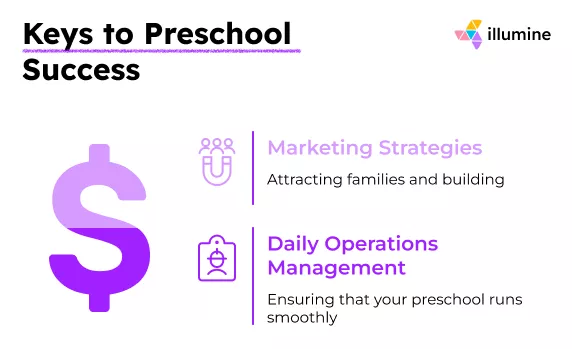
Step 14: Market Your Preschool Effectively
Even the most wonderful school needs visibility. Marketing is how families discover your story and begin to trust you.
Consider these strategies:
- Build a Website: Share your philosophy, staff bios, tuition details, and photos of your classrooms.
- Engage on Social Media: Use authentic photos and stories. Parents love seeing real moments from the classroom.
- Join Local Events: Sponsor children’s fairs or parent workshops to meet families in person.
- Encourage Referrals: Offer discounts or small tokens of appreciation to families who refer new students.
- Create and Distribute Marketing Materials: Design flyers, brochures, and digital content to showcase your preschool’s unique features and attract families.
Marketing is not about competition. It is about communication — helping families find the environment that best fits their child.
Step 15: Manage Daily Operations and Maintain Quality
The first year will teach you more than any manual. Create systems early that keep your school running smoothly.
- Use digital tools to track attendance, billing, and communication.
- Keep financial records up to date and review them monthly.
- Schedule regular team meetings to discuss what is working and what can be improved.
- Conduct quality audits of classrooms, safety, and parent satisfaction.
When daily operations are stable, you can focus on what truly matters — building relationships and nurturing growth.
Long-Term Planning
Once your preschool is stable, it is natural to think about growth. Some schools expand by adding new classrooms or age levels, while others replicate their model in new locations. Whichever path you choose, plan carefully so that your values and quality remain intact.
If you are considering franchising, explore it with patience and due diligence. Franchising can open new opportunities but also brings new responsibilities, systems, training, and consistency become even more important.
Final Words: Building a Preschool That Lasts
Opening a preschool is both a business and a calling. It begins with a dream to offer children a place where they can grow with joy and confidence. It also requires clear plans, steady finances, and strong systems.
If you take the time to prepare, to study your community, plan your facility carefully, and build a team that shares your values, your preschool will stand the test of time. Licensing, budgeting, and compliance are not just technical steps. They are the framework that protects your mission.
Remember, every decision you make tells families who you are. A thoughtfully built preschool does more than educate children. It shapes the lives of teachers, parents, and the community around it.
Building a school is, in many ways, an act of love and faith. When done with care, it becomes a legacy.


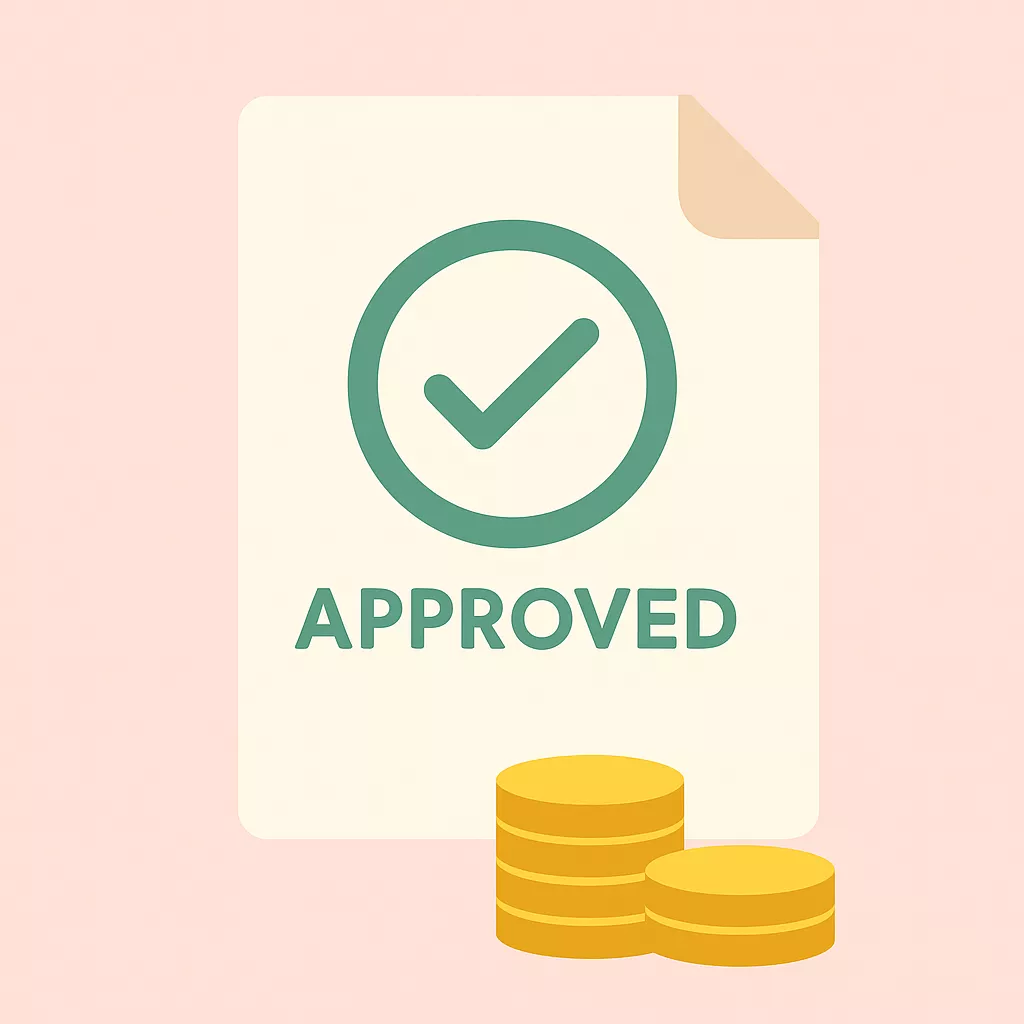







.webp)